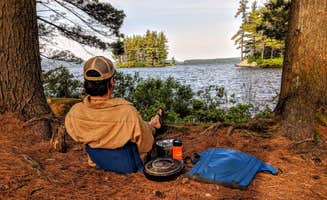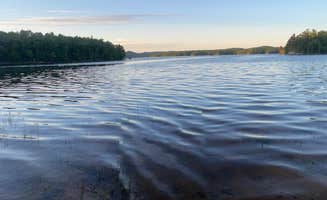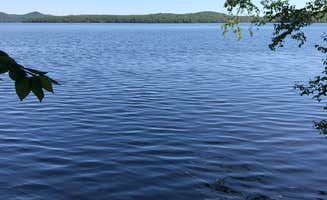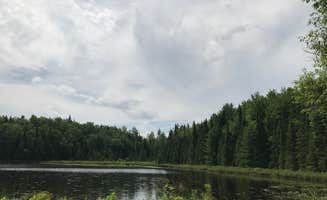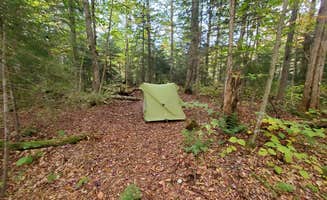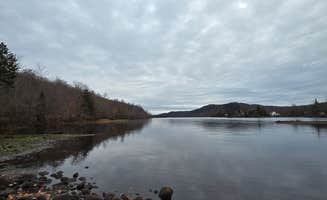Rustic camping near Oswegatchie, New York encompasses primitive sites across several interconnected watersheds in the northwestern Adirondacks. The region sits at elevations between 1,500-1,700 feet, creating distinct microclimates that affect water levels seasonally. Most dispersed sites require minimal site preparation as the forest floor remains relatively clear due to the predominant evergreen canopy.
What to do
Paddle between campsites: From Stillwater Reservoir, campers can access multiple islands and coves not reachable by road. "My wife and I kayaked to Long Island and stayed for a weekend. It was quiet and had the whole island to our self. Would recommend if you want to break away from technology because you get zero service out there," notes one visitor.
Swimming in clear waters: Most lake sites feature naturally sandy or pebbly shorelines ideal for swimming without requiring water shoes. A camper at Blue Lagoon Primitive Dispersed Camping reports, "Primitive site on the beautiful south eastern end of Stillwater. A short hike in to a great beach for swimming or paddling. The swimming is fantastic- water is clean and clear."
Hike connecting trails: Many dispersed sites connect to broader trail networks. "This site is close to the trailhead for the Stillwater firetower, an original Adirondack firetower," mentions one Blue Lagoon camper. The Curtis Pond trail near Cranberry Lake features extensive beaver dams accessible during day hikes from island campsites.
What campers like
Complete disconnection: The lack of connectivity becomes a feature rather than inconvenience for many. At Sunday Lake Dispersed Camping, "This is a small primitive site. No services, but a very beautiful spot. There's a small fire ring, and access to the lake for swimming or fishing. Sunday lake has always been lovely and quiet and a great place to take youth campers."
Island camping experiences: Several sites offer the opportunity to camp on islands. At Seventh Lake Primitive Camping, "We accessed the sites by water on a canoe trip. There is a large sand bar within a very short walk which was a great place to hang out. Seventh lake is pretty quiet but there were a few boats there both days we visited."
Wildlife encounters: The undeveloped nature of the sites enhances wildlife viewing opportunities. A Stillwater camper described their experience: "Even in cold rainy weather we had a phenomenal time at Stillwater. Our spot had gorgeous waterfront to it, a stone fire circle where someone had left extra fire wood, and ample trees. The season had had unusually low water all over and it left a really unusual landscape on the beach to explore."
What you should know
Access challenges: Many sites require careful planning and appropriate transportation. One Stillwater visitor notes, "a 20 mile ride of just woods on a bumpy road. Pretty cool! Surprisingly the place wasn't that populated as I expected it to be."
Limited amenities: Bring everything needed for your stay. A Polliwog Lake camper simply states: "Camped here for a few days, no cell, no internet."
Seasonal considerations: Water levels fluctuate significantly throughout the season, affecting shorelines and accessibility. One visitor observed, "The season had had unusually low water all over and it left a really unusual landscape on the beach to explore."
Specific site knowledge: Learning about site locations requires research or exploration. For Sunday Lake, a visitor advises, "Take Stillwater rd. to McCarty road, the trail is 0.3 miles To Sunday lake. Space to park two cars or a small RV off the road."
Tips for camping with families
Choose accessible sites: Some locations better suit family needs. At Little Green Pond, "12 designated camping spots. Some require driving down a bumpy access road that can be muddy after a rain. Sites are on the Pond. Pond has a small beach to swim. Tree covered sites."
Consider group size limitations: Most sites accommodate only small groups. Sunday Lake gets recommended specifically as "a great place to take youth campers," but parties should remain small due to limited space.
Plan activities beforehand: Without electronic entertainment, prepare nature-based activities. "We saw Bald Eagles and Loons, enjoyed swimming, canoeing and paddleboarding with the family," describes a Stillwater camper about their experience.
Pack insect protection: Bug pressure varies by location and season. One camper notes, "While the mosquitoes weren't bad at the campsite itself or while kayaking, they are terrible on the trails this time of year; so bring your bug spray, or better yet, bug shirts!"
Tips from RVers
Limited RV access: Only certain sites accommodate vehicles. A Stillwater visitor points out, "I came here a couple days ago only to realize that all except one campsite needs a boat to be reached. It's first come first serve so best to find another place if you intend to drive up to your campsite."
Parking constraints: Even for sites accessible by vehicle, parking remains limited. At North Lake Reservoir Campground, "32 sites all around the lake. Some are walk in right on the lake. Quiet, peaceful, and clean. Make sure to take a left at the start of the lake, the right is all private road and you will have to turn around."
Solar power challenges: For those relying on solar setups, tree cover impacts effectiveness. One Horseshoe Lake camper notes, "As it's a forest, the sites are pretty shaded, so solar and Starlink may present challenges. Slight AT&T at earlier sites."


